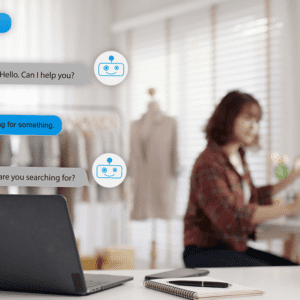Brands and retailers frequently partner with design strategy firms and tech integrators to bring new store concepts to life. But what does meaningful collaboration look like, especially as budgets and priorities shift?
For Purple’s Senior Director of Retail Environments, Cindy Speters, it means “being honest, almost to the point of pain.” And that honesty is critical for Speters, especially as she considers the scale and cost of new projects.
That’s how she described the brand’s partnership with Felbro Displays during a session at the Retail Innovation Conference & Expo last month in Chicago. She and Robert Price, EVP of Global Sales and GM of Omnichannel Retail for Felbro, gave a joint presentation about how the companies collaborated to bring a new store concept to market — from render to reality.
At the core of a successful partnership is clear alignment on goals and objectives. “How do we give consumers a reason to get off their sofa, come to the store and have a physical experience?” Speters asked. “It’s critical that at the onset, we are super clear with business partners and that we have alignment on the plan.”
Once an objective is set, brands and their partners need to ensure they walk through the entire process collaboratively. Speters and Price outlined the many steps involved and shared these six best practices:
1. Incorporate all stakeholders and decision-makers.
While every retail initiative requires input from both stakeholders and decision-makers, it’s also true that stakeholders aren’t always the final decision-makers. Executives need to understand the unique role that everyone plays in the process and where they should have input, Speters explained. “Who are those people and when should they have a seat at the table? You have to diagnose who those people are and who, at the C-level, will push the project to completion and have your back.”
For example, Speters works directly with the CFO to ensure no one on the executive leadership team is surprised about budgets. “You want them to feel like they’re part of the process and that they have a voice at the right time,” she said.
2. Integrate marketing into the process.
Of all roles and functions, Speters noted that marketing is especially central to store design processes, since marketing’s job is to help ensure that key brand messaging and differentiators are conveyed consistently and impactfully throughout spaces. This was especially true for Purple’s tech-integrated space because “we are challenging how we educate and talk to the consumer [in the store],” Price explained.
For example, the store experience does not have a traditional point of sale. Consumers and associates complete transactions via tablets, so the Purple team had to incorporate signage to ensure consumers understood that they could complete a purchase anywhere and at any time.
Advertisement
3. Ideate and conceptualize using various tools.
The concepting process includes initial ideation as well as visualization. To develop the initial idea, Purple and Felbro developed mood boards, conducted market tours and conducted in-depth analysis of the competitive landscape. The team even used AI tools like Midjourney to formulate new concepts.
“There’s that initial process of taking your knowledge and figuring out where you need to go, and then you need to share information so you can visualize it before you spend all the dollars to build it,” Price said.
Agencies support this ideation, but it’s up to internal design teams to ensure these ideas are rooted in reality. “[Agencies] paint a fabulous vision, but you have to bring it back to what is functional and scalable, and what really serves the customer in their journey,” Speters advised. “The experience is incredibly important, especially in the mattress category, but you don’t want to inhibit their journey either. You have to make sure what you’re putting in front of them allows them to explore in a way that’s frictionless, exciting and engaging, and gives them that reason to stay.”
Once ideation was complete, the teams did in-depth research on tactical elements, including material selection and fixtures. Then, they developed rich 3D renderings that allowed everyone, especially key stakeholders, to review entire mockups and understand how consumers would flow through the store. Before they started the live build, they ordered physical samples to get final buy-in from the Purple team.
4. Scale for efficiency.
Scaling is critical to managing project expenses, according to Speters. While a flagship store can be a one-off experience, ideally it should inform the rest of the fleet. “A flagship should be this incredible experience and the beacon for the brand, but how does that story evolve into the fleet?” she said. “Is it small touches or an overhaul? How does it play into the fleet moving forward so there’s a thread tying back [to the flagship]?”
Scale also can be achieved via modularity, which was baked into the design strategy for the Purple-Felbro project. “We knew from the start that this had to be a modular, scalable program from concept to prototype to materials,” Price said. “It had to be done in a way that had efficiency for cost and change. You have to be able to pivot quickly, so the system is quite flexible at its core.”
5. Use technology to surprise and delight.
Purple was focused on using technology in a purposeful way to support store shoppers and associates. However, the brand had to strike the right balance — being cutting-edge but also helpful.
“We thought the technology was critical, especially as leaders in our space,” Speters said. “But the question was, how do we make it more domestic and feel familiar, so consumers feel comfortable in the store, but they know cool things are still going to happen.”
To incorporate “cool” elements that added an element of surprise, Felbro considered the natural movements consumers made as they tested Purple mattresses. When consumers laid down on a mattress, sensor triggered content to play a digital screen on the ceiling.
6. Measure performance.
Once a new concept is in market, “you can pat yourself on the back about how fabulous a store is, but does it actually function and do consumers like it?” Speters said. This reaffirms the importance of measurement and analyzing human behaviors to improve experiences over time.
Although store sales and volume are the top indicators of success, heat maps provide more clarity around the consumer journey, dwell time and how the experience can be improved to drive results. The heat maps indicate where consumers spend their time in stores, and “it’s really important we understand that and that we’re putting assets in the right place,” she added. Purple not only measures the performance of the overall concept but of individual fixtures. The modular nature of the store enables the team to adjust layouts, signage and more, based on the data they receive.
















